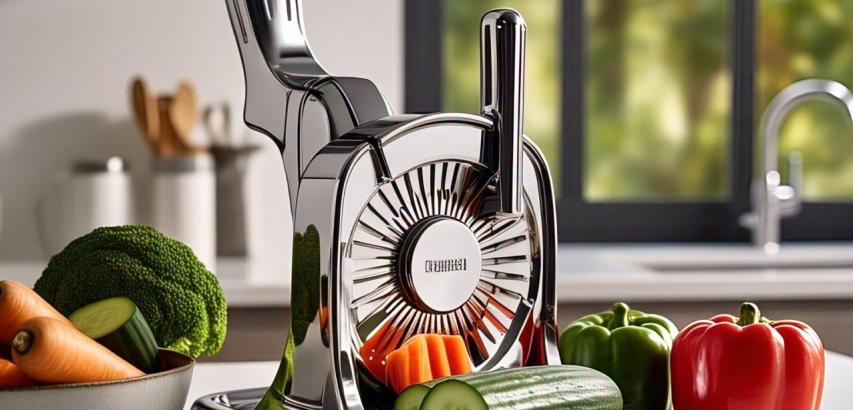A vegetable slicer is a kitchen tool or appliance designed to cut vegetables into uniform slices, strips, or shapes quickly and safely. Ideal for home cooks, professional chefs, and food processing industries, these devices streamline meal prep, enhance presentation, and reduce manual labor. From simple hand-held gadgets to advanced electric machines, vegetable slicers cater to a wide range of culinary needs.
Key Features and Technology
Blade Variety:
Adjustable blades for slicing, julienning, shredding, or spiralizing (e.g., thin slices, crinkle cuts, matchsticks).
Adjustable Thickness:
Dial-controlled settings to customize slice thickness (0.5mm–10mm+).
Safety Mechanisms:
Food holders, finger guards, and non-slip bases to prevent accidents.
Materials:
Stainless steel blades, BPA-free plastic bodies, or ceramic blades for durability and hygiene.
Ease of Cleaning:
Dishwasher-safe components or quick-release blades for hassle-free maintenance.
Power Options:
Manual slicers (hand-operated) vs. electric models (corded or battery-powered).
Types of Vegetable Slicers
Mandoline Slicers:
Manual, handheld tools with adjustable blades for precise slicing (e.g., Benriner, Mueller).
Electric Food Slicers:
Motorized devices for high-volume slicing (e.g., deli-style machines for cucumbers, potatoes).
Spiralizers:
Create vegetable noodles (zoodles) from zucchini, carrots, or sweet potatoes.
Food Processors with Slicing Attachments:
Multi-functional appliances (e.g., Cuisinart, KitchenAid) with interchangeable blades.
Vegetable Chippers:
Compact tools for dicing onions, mincing garlic, or chopping herbs.
Applications
Home Cooking: Simplify meal prep for salads, stir-fries, or garnishes.
Restaurants and Catering: Ensure consistent cuts for plating and bulk food prep.
Meal Kit Services: Pre-slice vegetables for portion-controlled packaging.
Health-Conscious Diets: Create low-carb alternatives (e.g., zucchini noodles).
Food Preservation: Slice vegetables evenly for drying, pickling, or freezing.
Advantages
Time-Saving: Cuts prep time by up to 80% compared to manual knife work.
Consistency: Uniform slices for even cooking and professional presentation.
Safety: Reduces the risk of knife-related injuries.
Versatility: Handles a wide range of vegetables (carrots, potatoes, cucumbers, etc.).
Space Efficiency: Compact designs fit small kitchens (unlike bulky food processors).
Considerations
Cost: Manual slicers cost $10–$50; electric models range from $30–$300+.
Blade Maintenance: Regular sharpening or replacement for optimal performance.
Storage: Some models require dedicated space for blades and accessories.
Learning Curve: Electric slicers may need practice to operate safely.
Vegetable Limitations: Hard vegetables (e.g., squash) may require heavy-duty blades.
Popular Models and Brands
Mueller Austria V-Pro Manual Slicer: Adjustable mandoline with multiple blades.
Ninja Foodi Spiralizer: Electric spiralizer for noodles and ribbons.
Cuisinart PrepExpress: Compact dicer and slicer with storage container.
Bosch Universal Electric Slicer: Heavy-duty machine for commercial kitchens.
OXO Good Grips Hand-Held Mandoline: User-friendly design with safety features.
Innovations and Trends
Multi-Functional Attachments: Combine slicing, grating, and shredding in one device.
Eco-Friendly Materials: Sustainable bamboo or recyclable plastic designs.
Smart Sensors: Auto-stop features in electric slicers when detecting obstructions.
Compact Travel Slicers: Portable tools for camping or small kitchens.
A vegetable slicer is an indispensable tool for anyone seeking efficiency, precision, and safety in the kitchen. Whether you’re a home cook aiming to speed up dinner prep or a chef perfecting restaurant-quality dishes, these devices offer unmatched versatility and consistency. While manual slicers are budget-friendly and portable, electric models excel in high-volume settings. Innovations in blade technology and ergonomic design continue to enhance usability, making vegetable slicers a smart investment for modern kitchens. Slice smarter, not harder! 🥒🔪
Pro Tip: Always use the food holder or guard provided, and start with softer vegetables (like cucumbers) to practice before tackling harder produce.
 |  |  |
